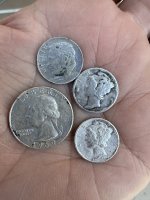biglizer
Jr. Member
- Dec 28, 2016
- 28
- 4
- Primary Interest:
- All Treasure Hunting
Hello folks
I have a big problem when i survey new areas ,even in a known target ,the signal line sometimes tend to shift from its original position of target causing false location ,sometimes the reflection fluctuates from few inches to some feets
Am using signal generator,l-rod,two ground probes waiting for 10 minutes then i start to survey
For mfds GURUS please share your experience
I have a big problem when i survey new areas ,even in a known target ,the signal line sometimes tend to shift from its original position of target causing false location ,sometimes the reflection fluctuates from few inches to some feets
Am using signal generator,l-rod,two ground probes waiting for 10 minutes then i start to survey
For mfds GURUS please share your experience
Last edited:




